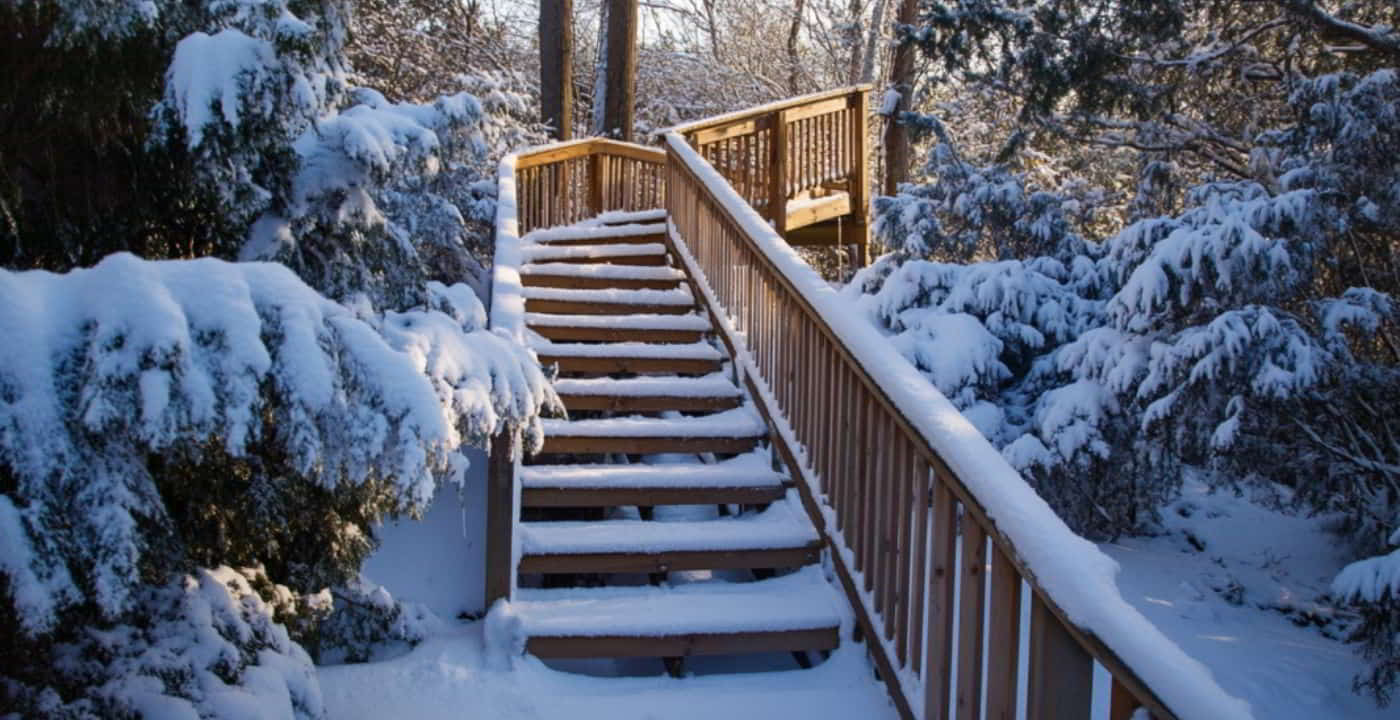When winter hits, icy steps can turn your front entry into a risky adventure.
With heated outdoor stair mats or embedded systems, you can say goodbye to slipping, shoveling, and salting.
From easy plug-in mats to built-in options for heavy snow, these heating solutions keep your steps clear, safe, and hassle-free all season long.
We’ll help you find your fit—because no one should have to skate their way to the front door.
Key Takeaways
- Heated outdoor stairs prevent slips, reduce salt use, and save shoveling time.
- Electric, hydronic, and mat-based systems fit different budgets and snow levels.
- These systems can lower maintenance costs and protect your stairs from winter damage, making them a smart investment for colder climates.
Why Install Heated Outdoor Stairs?
If you live somewhere with regular snowfall, outdoor stairs are a major safety concern during the winter.
Snow and ice quickly accumulate and cause slipping hazards. But removing these icy obstacles takes time and effort.
Heated mats for steps and other snow-melting solutions can save you from constant shoveling while providing a safer, slip-resistant surface.
Here are some of the main benefits slip-free stairs bring you:
1. Enhanced Safety
Preventing falls on icy steps is the biggest reason to invest in anti-ice mats for steps.
These mats keep snow from accumulating and ice from forming, so lower the chance of dangerous slips.
2. Reduced Environmental Impact
Outdoor heated stair mats don’t use salt or chemicals.
These can damage concrete, harm plants, and affect water systems.
3. Ease and Convenience
Once installed, you can pretty much ignore your melting mats. Plug them in, set timers if available, and they’ll take care of the snow.
4. Protects Property
Heated mats reduce snow shoveling, which damages stairs over time. They also prevent salt and chemicals from degrading concrete or wood.
Types of Heated Stair Systems

Several systems exist for snow and ice control on stairs.
The choice depends on your stair setup, how much snow you get, and your budget.
Here are the main types:
Electric Heating Systems
Electric heating systems are usually installed when you’re fitting new stairs.
They are made up of electric heating cables embedded in materials like concrete or asphalt, making them effective for consistent snow melting in even the harshest climates.
Because they’re installed as part of the stair structure, they’re ideal for long-term use.
Features of Electric Heating Systems
- Energy-Efficient Design: They turn on automatically or via timers, minimizing wasted energy.
- High Effectiveness: Electric systems work well in extreme weather, melting ice even at low temperatures.
- Customizable Layouts: Designed to fit any stair shape or size, they offer flexibility for unique setups.
Electric heating is perfect if you want to prioritize easy maintenance and are planning on constructing or renovating outdoor stairs.
Hydronic Heating Systems
Hydronic heating systems use heated water running through pipes embedded in the stairs.
The water warms the stair surface, melting snow and ice.
It’s an energy-efficient approach, especially for large areas like driveways, but it’s also more expensive due to its installation complexity.
Features of Hydronic Systems
- Energy Efficiency: Saves on electrical heating costs, particularly over large areas.
- Durable and Long-Lasting: Works well in climates with regular snow and can handle constant operation without losing effectiveness.
- Higher Initial Cost: Your upfront installation costs are high, but this is partially offset by lower operating costs.
Hydronic heating is best for large installations, like stairs, driveways, or walkways in areas with consistent snowfall.
Heated Stair Mats
If you’re looking for an easy and flexible solution, outdoor heated stair mats are the answer.
You place the plug-in mats directly onto your existing stairs and they use an electric heating element to melt snow and ice.
For convenience, you can connect your snow-melting mats to each other to create the coverage you need.
Heated Stair Mats
Features of Heated Stair Mats
- Easy Installation: Just lay the mats on each step and plug them in.
- Portable and Versatile: You can remove and store them when not needed.
- Affordable: Compared to embedded systems, mats are less expensive upfront and don’t require professional installation.
Heated stair mats are great for homeowners who need a flexible, seasonal solution without permanent changes to their stairs.
Comparison: Types of Heated Stair Systems
| Feature | Electric Heating | Hydronic Heating | Heated Stair Mats |
|---|---|---|---|
| Energy Efficiency | ✔️ | ✔️ | ✔️ |
| High Effectiveness | ✔️ | ✔️ | ✔️ |
| Easy Installation | ❌ | ❌ | ✔️ |
| Portable | ❌ | ❌ | ✔️ |
| Affordable | ❌ | ❌ | ✔️ |
Cost of Snow Melting Mats for Stairs
The costs for snow melting systems vary depending on the type, installation requirements, and system size.
Here’s a closer look at the breakdown:
Initial Purchase Costs
The cost of heated mats is typically lower than other systems. Prices for a single mat range from $80 to $300, depending on size and wattage.
Hydronic and electric heating systems are more expensive, especially when factoring in installation.
Installation Expenses
You don’t have to call in professionals to install your heated stair mats.
If you’re going with an electric or hydronic system, you’ll need an experienced contractor. Expect to spend at least $1,500 – $2,500 or more on pro installation.
Operating Costs
Snow melting mats for stairs generally don’t cost much to run.
If you’re choosing snow melt mats from Green Wave Distribution, expect your energy costs to average out at $1.60 to $3.20 per hour for 120-volt mats.
Hydronic systems tend to be even more energy-efficient, although they require a boiler.
Installation Considerations
Before installing heated mats for steps make sure you have an electrical outlet near your stairs. In addition, hydronic systems might need a dedicated water source.
Measure your stairs to determine the right size and type for effective coverage.
Tired Of Turning Your Stairs Into An Ice Rink?
Maintenance & Safety Tips

Maintaining anti-ice mats for steps is simple but important.
Here are some basic tips:
- Inspect Periodically: Look for signs of wear, such as exposed wiring or cracked surfaces.
- Store Properly: Roll up mats and store in a dry place during warmer months.
- Avoid Heavy Loads: Don’t place heavy objects on mats, as this can damage the heating elements.
Pro Tip: Position your mats securely to cover the high-traffic areas of each step. This optimizes melting and prevents gaps where ice can accumulate.
Frequently Asked Questions
How much do snow-melting mats for stairs cost?
Snow melting mats typically cost between $100 and $300 per mat, with prices varying based on size and wattage
Do you get snow-melting mats for deck stairs?
Yes, many snow-melting mats are versatile enough to use on deck stairs. Just ensure the mat size fits your deck steps.
How do you remove snow from stairs?
Heated stair mats make it easy: just plug them in, and the snow melts on contact. For built-in systems, use timers or thermostats to ensure they activate during snow events.
How can I heat my outside steps?
Heating outside steps is as easy as laying down heated mats or installing an electric or hydronic system during stair construction. Both options work to melt snow and ice effectively.
Pack Away The Shovel
Don’t let winter turn your stairs into a hazard zone.
Whether you choose plug-and-play heated mats starting at $100 or opt for built-in systems, snow-melting solutions offer more than just safety – they protect your property, cut down on maintenance, and eliminate the need for environmentally harmful salt.
Think of it as an investment in peace of mind and hassle-free winters. Skip the morning shovel routine and the stress of watching guests navigate icy steps.
Ready to make winter worries melt away? Contact us for a free quote today.






